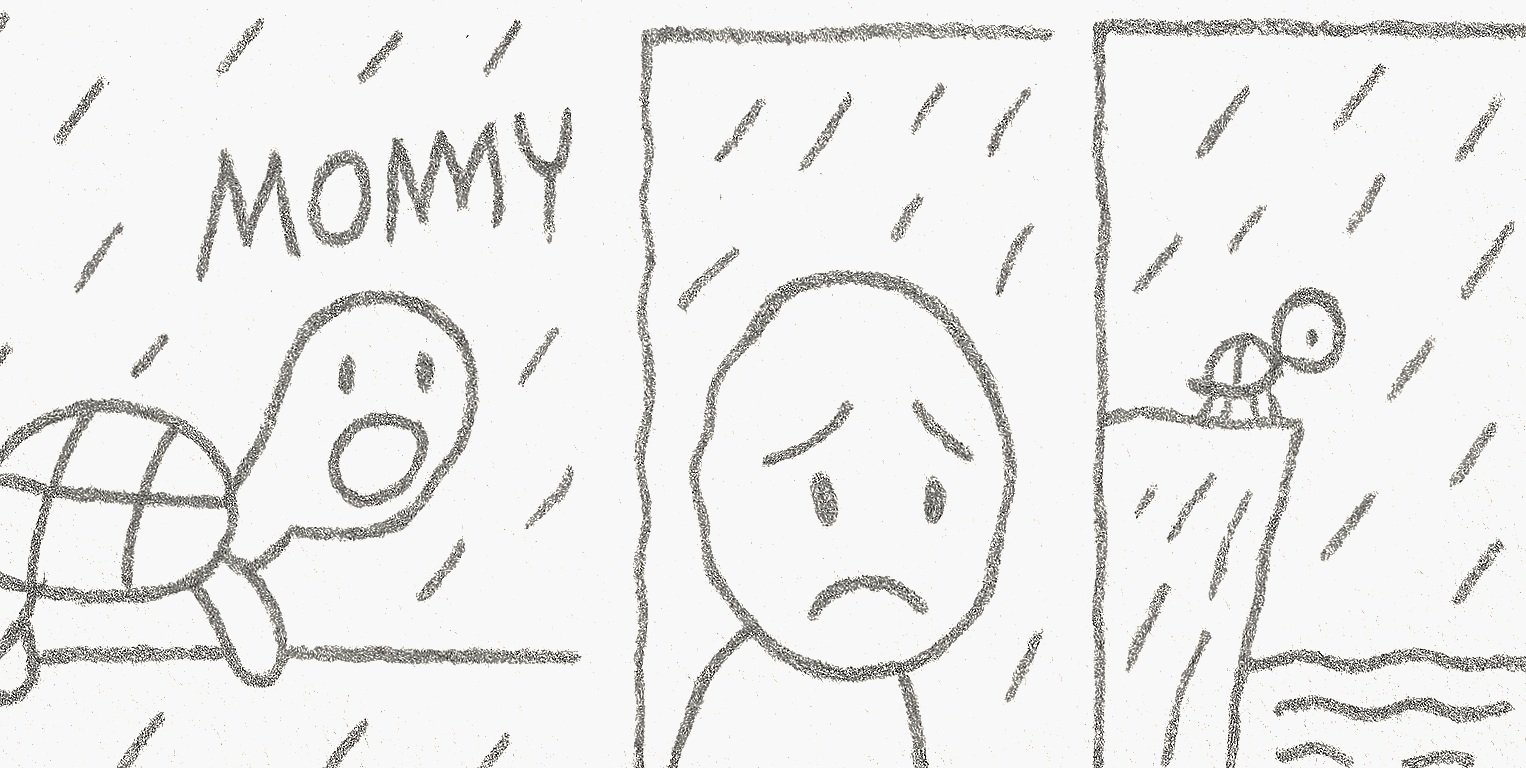Note: These excerpts are following Joe through the process of teaching kids how to make an animated movie, or as the kids put it, "content". First draft. Today's excerpt is back in the classroom after a brief interlude in the teachers lounge.
Joe re-enters the classroom with a kind of cheerful urgency, like a coach calling the final play of a big game.
“Alright! Everyone except the Turtle Group—grab your bins and get ready to present the rest of those big, beautiful storyboards!”
He pauses, letting the rustle of plastic bins and shuffling chairs settle into a quiet hum.
“Bowling Ball Group—you’re up!”
As in every session, the young creators line up confidently at the front of the room. After a quick sound check they raise their illustrated scenes high above their heads. One by one, they step forward and explain the action, the emotions, and the choices behind each scene.
Joe listens closely, then steps in to sum up for the class, checking for clarity.
“Alright, just so we’re all on the same page: the hero of this story is a bowling ball. But it’s not a great day at the lanes. A beginner bowler—whose face we never see, just a big hand—chooses our hero from the rack and keeps rolling gutter balls. And every time our hero rolls past the pins, they mock him. Is that right?”
The group nods.
“We’re hoping to make up some funny stuff the pins might say,” one student explains. “Maybe even something the ball could say back to the bad bowler.”
Joe nods approvingly. “Our dialogue session is coming up soon, so you’ll have time to brainstorm those exchanges. That kind of back-and-forth is where a lot of comedy lives.”
He glances back at their final scenes.
“Now, let me check this bit: At the end, the big hand gives up on our hero and puts him back on the shelf. Then it picks a new ball. But that one also rolls straight into the gutter... and it gets mocked by the pins, too?”
“Yes,” they confirm in unison.
“Got it.” Joe flashes a thumbs up, then turns to the class. "So the movie ends with our hero being relieved it isn't its fault for missing the pins. It's that big huge uncoordinated hand!"
"Yes!" the presenting group says in unison.
“Any questions for the Bowling Ball Group? Remember—this isn’t the time for opinions about whether you like the story or not. These are early drafts. Our job is to ask about things that confuse us. That’s how we help each other make things better.”
Three hands rise. Joe points to one.
“Yes, Jasmin?”
Jasmin frowns slightly. “Does the ball ever actually hit the pins? Even once?”
Joe raises an eyebrow. “What part of that is confusing?”
“I just figured the ball would eventually knock the pins over—to shut them up. I mean, that’s the whole point of bowling, right? It feels weird that the ball never hits them.”
The other two hands go down. Clearly, she voiced what they were thinking too.
Joe tilts his head thoughtfully. “Anyone else feel that way?”
Most hands go up.
“Well, that’s interesting,” Joe says. “See, I loved the idea that no matter which ball the hand chooses, it’s destined to be a gutter ball. That spoke to me. It felt like a story about forces beyond our control. About not taking failure personally when you’re doing your best.”
He looks back at the presenters. "Maybe I have some unresolved issues from childhood." Joe offers with a smile. The teacher looks up from grading papers in the back with a wry smile.
“Somebody out there—what do you think should happen instead?”
One student blurts out, “The ball should roll a strike and take out all the pins while they’re teasing him!”
A chorus follows. “Yeah!” “That’d be awesome!”
Joe grins. “Ahh, revenge. That’s a very different ending.”
Suddenly, a voice from the back bursts into a musical chant: "Na na na na... ba bump ba bump... can’t touch this… na na na na… ba bum ba bum—CAN’T TOUCH THIS... BAM!"
A wave of laughter sweeps the room as the student adds sound effects of pins crashing and being whisked away by the pin-reset machine, screaming all the way.
Joe laughs with them. “That’s hilarious. I can totally picture the pins taunting the ball with ‘Can’t touch this.’ You’ve got to do the voiceover. You’ve nailed it.”
Laughter.
He glances back at the presenting group. “I love both endings. Honestly, I’d have a hard time choosing. One is subtle and one is blunt force trauma. But that’s the beauty of early drafts—you can experiment. You’ve got great feedback from your audience. Now it’s up to you. You can erase some of your stick figure storyboard scenes and go a different direction... or not. It’s your story.”
“Next group! Rocket Stealer!”
The next two groups present their full-color storyboards with strong, clear voices. Joe gives a few helpful nudges—pointing out a Long Shot where a Close-Up might land better, or asking for clarity on a scene transition—but for the most part, the stories are well-structured and engaging. By the end of the session, four movies are storyboarded and ready for production.
Joe claps his hands once, a little dramatically.
“Okay! The hard part is done.”
He lets that hang in the air.
“Story is difficult. Animation is easy.”
The kids look up, puzzled.
Joe leans on the whiteboard and explains.
“What I mean is, no amount of beautiful animation or special effects can rescue a bad story. Whole films—millions of dollars' worth—have been scrapped because the test audience didn’t care. Gorgeous visuals. Empty plot. Gone.”
A few students gasp.
“Some of these movies took as much money as it takes to build a sky-scraper. A fortune lost because even grown-ups don't test to see if their movie is working BEFORE they shoot it." Joe says with bugged out eyes.
He let's that hang in the air and waits for what seems like an eternity before continuing..
"Look up Willow, or the Batgirl movie with Halle Berry. You’ll see what I mean.”
He leans in.
“Now on the flip side, if you’ve got a good story and strong characters, you can put a sock on your hand and still entertain an audience. You could even do it with hand shadows. Humans have been doing it for thousands of years. It’s not the technology that matters—it’s the storytelling.”
He looks around the room, locking eyes with a few students who had been nervous earlier.
“I’m really proud of you. You stood up in front of your classmates—even the loud ones—and shared something original. You shared your art. Your drawings. That’s hard. That takes courage. You weren’t sure how people would react, but you did it anyway. You stepped into the unknown… and you found out we’re all here to help each other succeed.”
He smiles. The room is quiet for a beat.
“And now... animation. Next time we’ll learn how to think like an animator. The basics. You’ve already practiced some of them, you just didn’t realize it. Remember when we pushed the chairs back and animated each other with our bodies? Same rules, different fools!”
He claps once again.
“It’s time to bring your characters to life. No one in the history of the world has ever seen them move—until now.”
He pauses, then grins.
“Excited?”
A cheer erupts across the room—shouts, laughter, clapping.
They’re in. They’ve got skin in the game now.
And the real magic is just beginning.
Joe says, "Bon Animate!" as he puts his fingers to his lips and makes a popping sound like a chef tasting a masterpiece.
He waves good-bye and smiles as he looks forward to introducing the Animation Chef's secret animation formulas next session.

